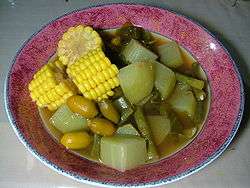Sayur asem
 Sayur asem | |
| Course | main course |
|---|---|
| Place of origin | Indonesia |
| Region or state | Jakarta, West Java, Banten |
| Created by | Sundanese cuisine and Betawi cuisine |
| Serving temperature | hot and room temperature |
| Main ingredients | various vegetables in tamarind soup |
Sayur asem or sayur asam is a popular Indonesian vegetable in tamarind soup.[1] Common ingredients are peanuts, young jackfruit, young leaves and unpeeled seeds of melinjo, bilimbi, chayote, long beans, all cooked in tamarind-based soups and sometimes enriched with beef stock. Quite often, the recipe also includes corn.
The origin of the dish can be traced to Sundanese people of West Java, Banten and Jakarta region. It is well-known belongs within Sundanese cuisine and Betawi daily diet. Several variations exist including sayur asem Jakarta (a version from the Betawi people of Jakarta), sayur asem kangkung (a version which includes water spinach), sayur asem ikan asin (includes salted fish, usually snakehead murrel), and sayur asem kacang merah (consists of red beans and green beans in tamarind and beef stock). The Karo version of sayur asem is made using torch ginger buds and, more importantly, the sour-tasting seed pods.
The sweet and sour flavour of this dish is considered refreshing and very compatible with fried or grilled dishes, including fish and lalapan, a kind of vegetable salad usually raw but can also be cooked, and is usually eaten with sambal terasi. Sayur asem rembang is a vegetable soup with a sour flavor.[2][3]
- Sayur asem

See also
References
- ↑ "40 of Indonesia's best dishes". CNN Travel. August 9, 2011. Retrieved January 30, 2015.
- ↑ Planet, L.; Berkmoes, R.V.; Brash, C.; Cohen, M.; Elliott, M.; Mitra, G.; Noble, J.; Skolnick, A.; Stewart, I.; Waters, S. (2010). Lonely Planet Indonesia. Travel Guide. Lonely Planet Publications. p. 81. ISBN 978-1-74220-348-5. Retrieved January 30, 2015.
- ↑ Bacon, D.; Collins, T. (2010). CultureShock! Jakarta: A Survival Guide to Customs and Etiquette. Culture shock!. Marshall Cavendish International Asia Pte Ltd. p. 217. ISBN 978-981-4435-56-7. Retrieved January 30, 2015.
External links
| Wikibooks Cookbook has a recipe/module on |
| Wikimedia Commons has media related to Sayur asem. |
- (in Indonesian) Sayur Asem Jakarta version